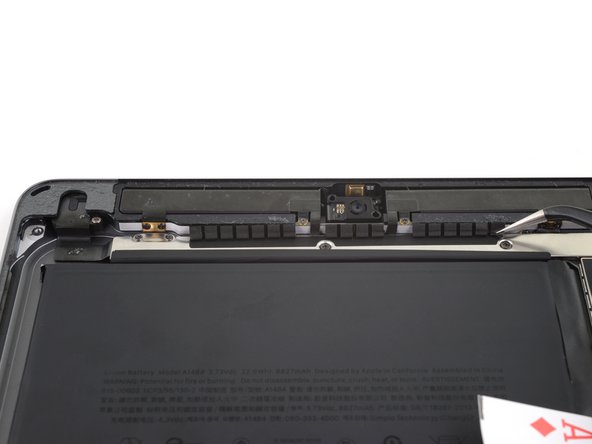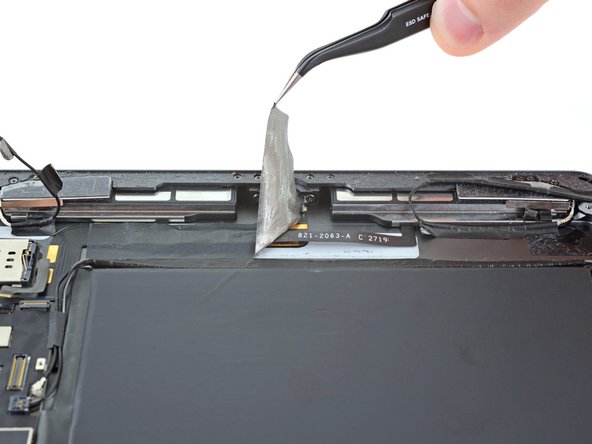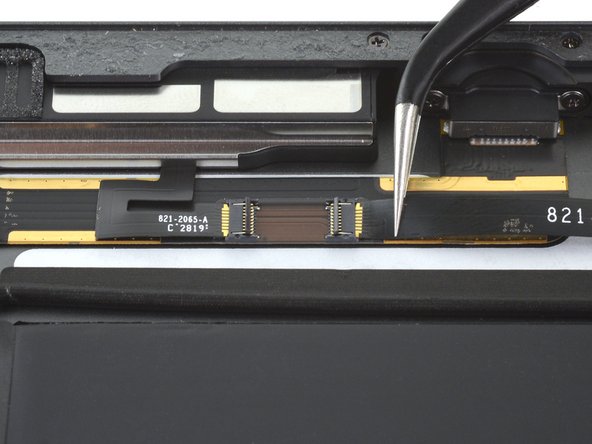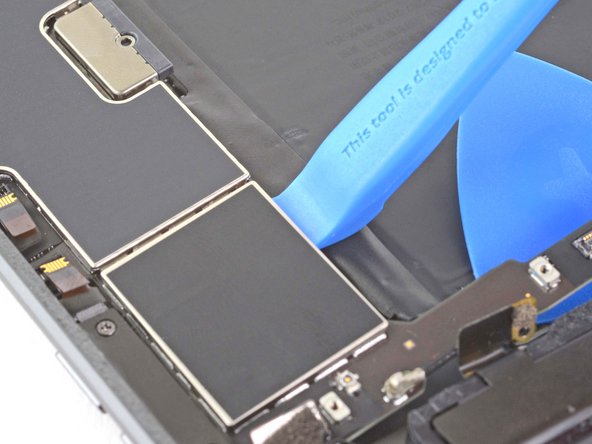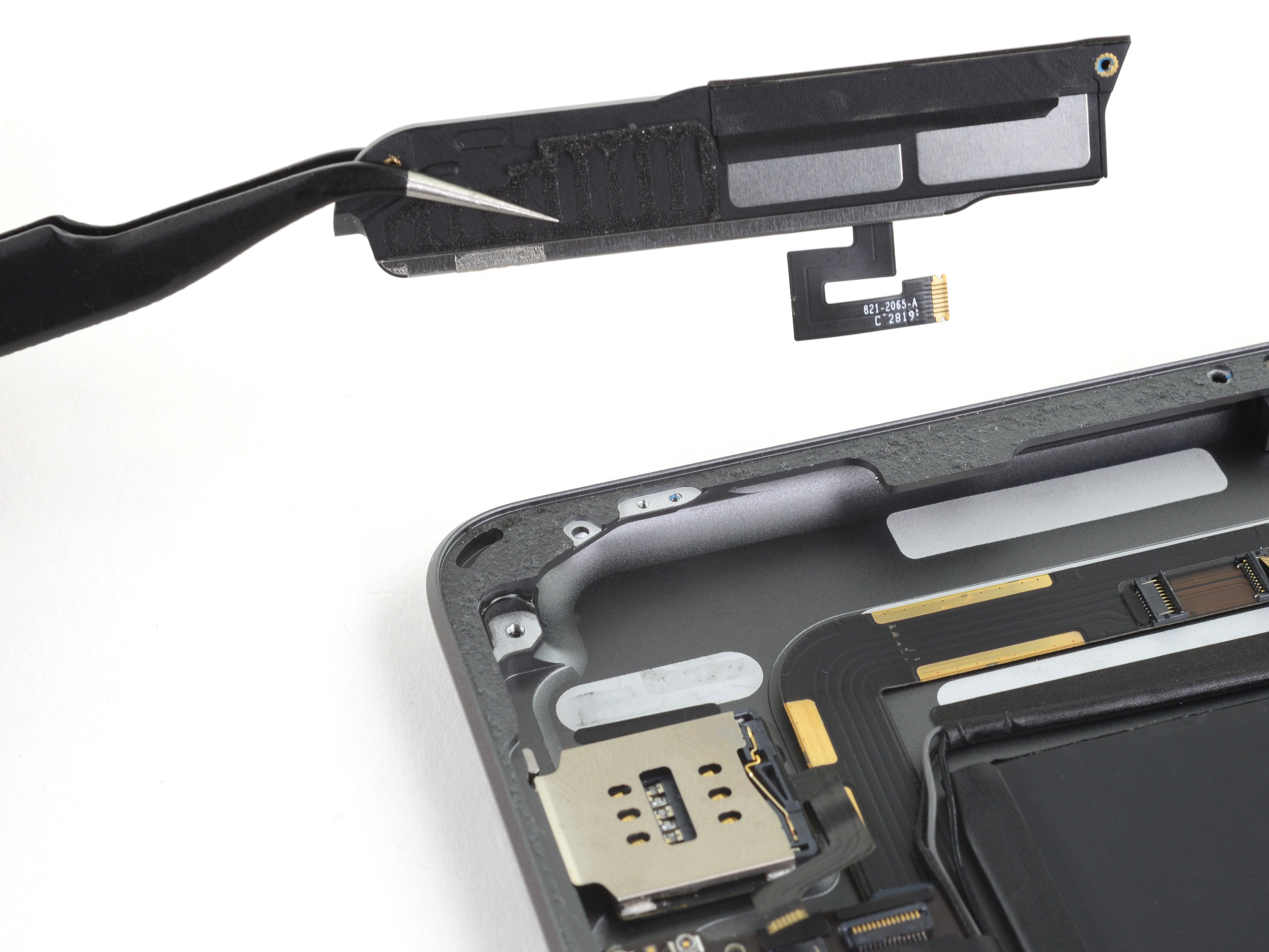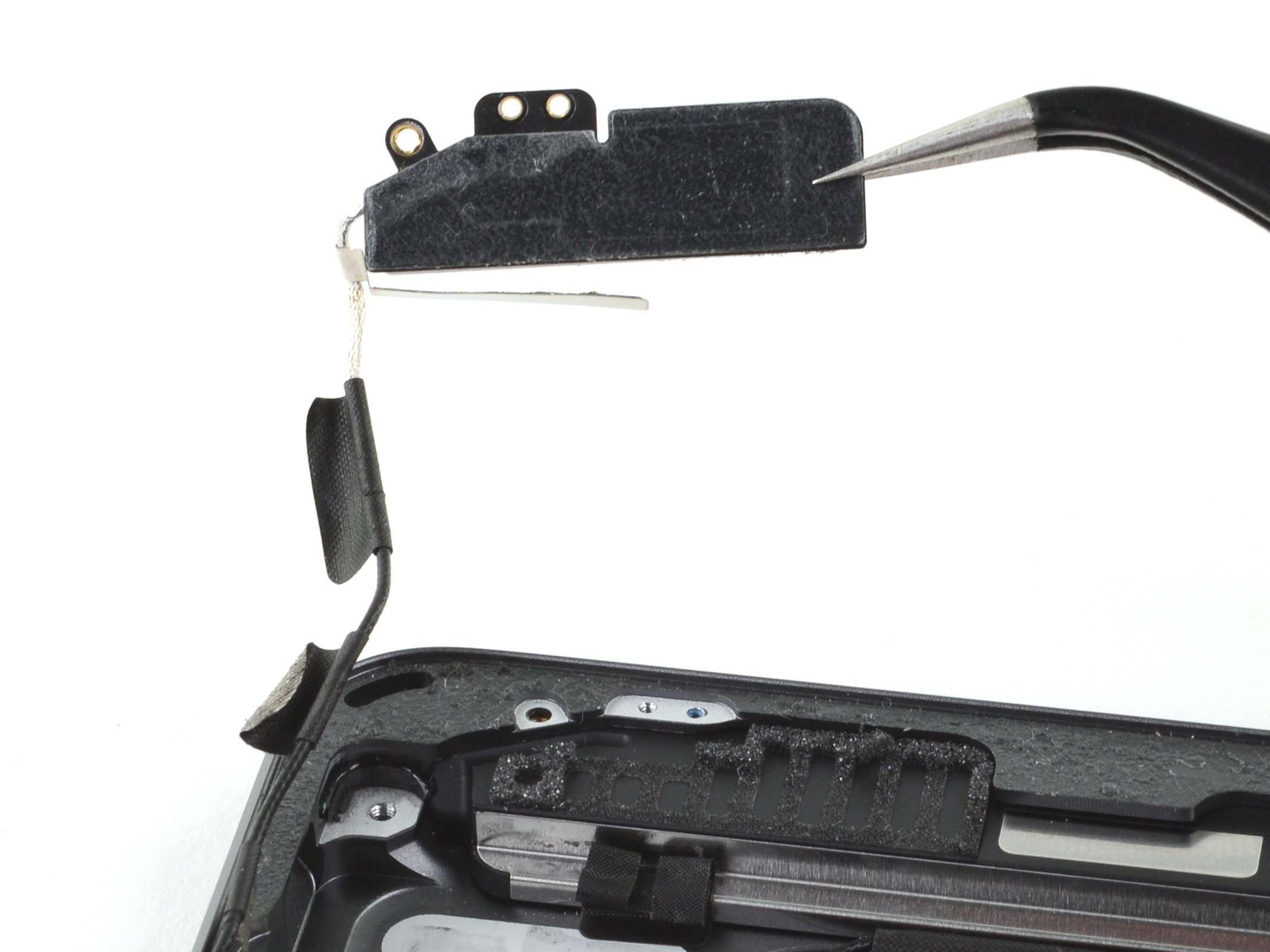iPad 7 Logic Board Replacement
Duration: 45 minutes
Steps: 95 Steps
Ready to swap out or replace the logic board in your iPad 7? Great! Keep in mind, this guide is tailored for the LTE version, so if you’re working with the Wi-Fi version, check out the other guide. When you isolate the battery with a battery blocker, tread carefully – the battery contacts are delicate, and any damage could spell permanent trouble. If you decide to skip isolating the battery, try to avoid using metal tools unless absolutely necessary (for example, when removing screws). This will help you dodge any short circuits or harm to sensitive components. A heads-up: some photos in this guide are from a different model, so you might spot a few visual differences, but don’t worry – they won’t mess with the steps you need to follow. Need a hand? If things get tricky, you can always schedule a repair.
Step 1
- Warm up an iOpener and let it work its magic on the left edge of the device for two minutes. It'll soften things up just right for the next step!
Tools Used
Step 2
- While waiting for that adhesive to loosen up, make sure you're aware of these delicate spots that can be a bit tricky when prying:
- Front camera
- Antennas
- Display cables
Step 3
Here come the next three steps featuring the Anti-Clamp — a nifty tool we whipped up to make the whole opening thing a breeze. Not using the Anti-Clamp? No worries! Just skip down a few steps for an alternate method.
Need the full scoop on how to work the Anti-Clamp? Check out this guide for all the deets.
If your iPad's surface is feeling a little too slick for the Anti-Clamp to grab onto, no sweat! Just use some tape to give it a little extra grip.
- Slide the blue handle backward to release the grip on the Anti-Clamp's arms.
- Set something under your iPad so it sits nice and level between the suction cups.
- Place the suction cups close to the center of the left edge—one up top, one down low.
- Keep the bottom of the Anti-Clamp steady while pressing down firmly on the top cup to get a good seal.
Step 4
- Pull the blue handle forward to secure the arms in place.
- Twist the handle 360 degrees clockwise, or until you see the suction cups stretching to their sweet spot.
- Check that the suction cups stay aligned. If they start to drift apart, just loosen them a bit, realign, and tighten them up again.
Step 5
Take it easy! Just give it a gentle half turn at a time and chill for a minute between each twist. Let the Anti-Clamp and a little patience do their magic for you.
For all the details on how to wield a hair dryer like a pro, be sure to check out this guide.
If the Anti-Clamp isn't giving you the gap you need, no worries! Just warm up the area a bit more and give that handle a half turn clockwise.
- Give it a minute to let the adhesive take a breather and form a small gap for you.
- If the screen’s not heating up enough, try using a hair dryer along the left edge of the iPad to warm things up a bit.
- Slide an opening pick under the digitizer once the Anti-Clamp creates a nice gap for you.
- Feel free to skip the next step. You're doing great!
Step 6
If your screen is sporting some serious cracks, slapping on a layer of clear packing tape might just do the trick for the suction cup to stick. You could also opt for some heavy-duty tape if you're feeling adventurous instead of using that suction cup. And if you find yourself in a pinch, a little superglue on the suction cup can help it cling to that battered screen.
- Once the screen is nice and toasty, grab a suction handle and stick it to the left edge of the screen, getting as close to the edge as you can.
- Gently lift the screen with the suction handle to create a little gap between the digitizer and the frame—you're doing great!
- Slide an opening pick into that gap between the digitizer and the frame. Keep it steady!
Tools Used
Step 7
No need to stress if you spot the opening pick peeking through the digitizer — just pull it out! The LCD screen should stay safe, but be aware you might end up with some stubborn adhesive to clean off later.
- Pop another opening pick into the gap you just made.
- Gently slide it down toward the bottom-left corner to break up that sticky adhesive.
- Keep the pick wedged there to stop the adhesive from sticking back together.
Step 8
- If the opening pick encounters some sticky adhesive, try giving it a little 'roll' action along the side of the iPad to keep separating that adhesive like a champ!
Step 9
- Gently slide the first opening pick towards the top-left corner of the device to break the adhesive seal.
- Leave the pick in that top-left corner to keep the adhesive from sealing back up on you.
Step 10
- Warm up your iOpener and gently place it on the top edge of your device for about two minutes. This will soften things up and make your job a whole lot easier.
Tools Used
Step 11
- Gently twist the pick around the top-left corner to loosen up that stubborn adhesive like a pro.
Step 12
Steer clear of sliding the pick over the front camera lens to keep it safe and sound. The next steps will guide you on how to dodge any lens mishaps.
- Gently slide the opening pick along the top edge of the device, stopping right before you reach the front camera—nice and easy does it!
Step 13
- Gently pull the pick out so that just the tip stays tucked between the digitizer and the frame.
- Slide the pick right above the front camera to carefully loosen the adhesive.
- Keep the pick resting near the right side of the front camera before moving on to the next step.
Step 14
- Pop the pick back in and gently glide it towards the top-right corner to fully break apart the top adhesive.
- Leave the pick chilling in the top-right corner to stop that sticky adhesive from sealing back up.
Step 15
- Warm up an iOpener and let it work its magic on the right edge of your device for a solid two minutes.
Tools Used
Step 16
- Gently twist the pick around the top-right corner to loosen up that stubborn adhesive and get things moving.
Step 17
The display cables hang out about halfway up from the bottom of your iPad. Slide carefully and stop when you’re about three inches from the bottom to avoid any surprises.
- Grab a fresh opening pick and gently slide it halfway along the right edge of the iPad.
Step 18
- Heat up an iOpener and give it a cozy spot on the bottom edge of your device for two minutes. Let the warmth do its magic!
Tools Used
Step 19
Avoid spinning the pick all the way around the corner—your antenna will thank you for being gentle!
- Gently slide your trusty pick into the bottom-left corner to break that adhesive seal like a boss!
- Keep the pick snug in that corner before you rock on to the next step.
Step 20
Gently slide the pick towards the home button—don’t push it the other way! You don’t want to risk messing up the antenna.
If you find yourself needing to slide that pick across this area again, just pop it out and reinsert it at the bottom-left corner. You've got this!
- Slide a fresh opening pick into the little gap you've just made at the bottom edge of your iPad.
- Carefully glide the pick over the antenna, making sure to stop just shy of the home button.
- Position the pick to the left of the home button before you carry on with the next steps.
Step 21
Be gentle with that pick! Only insert it up to 1 mm to keep the right antenna safe and sound.
- Slide an opening pick into the little gap you've just created.
- Gently move the pick under the home button and towards the bottom-right corner. Just let the tip hang out between the digitizer and the frame—no need to go too deep!
Step 22
Make sure to slide the pick toward the home button only, not away, to avoid any antenna mishaps. Keep it cool and steady!
If you need to slide the pick over this part again, just take it out and pop it back in at the bottom-right corner to keep things smooth.
- Gently re-insert the pick and slide it towards the home button to fully break the bottom adhesive seal.
- Keep the pick near the right side of the home button, and get ready to move on to the next step.
Step 23
- Warm up an iOpener and stick it on the right edge of your device for a solid two minutes to loosen things up.
Tools Used
Step 24
Take your time with this step—no rush! Make sure the adhesive is nice and soft, and use that pick to gently separate everything. If it feels tricky, don't be afraid to stop and reheat. Better safe than sorry, and you got this!
If you feel a lot of resistance, try reheating the edges and gently work along them with an opening pick.
- Gently twist the two opening picks at the left corners of the iPad to carefully lift the digitizer just a bit, loosening the last of the stubborn adhesive holding it down.
Step 25
- Gently lift the left edge of the digitizer upward to loosen the adhesive gripping the right edge of your iPad a bit more.
Step 26
- Keep a steady hand on the digitizer and carefully slide an opening pick between the two display cables to gently loosen the last bit of adhesive holding them together.
Step 27
- After carefully loosening all the adhesive, gently open the digitizer like a book and lay it flat alongside the iPad.
- When putting things back together, take a moment to wipe off any leftover adhesive from the frame—and from the digitizer if you plan to reuse it—using some isopropyl alcohol. Then, swap in fresh adhesive strips or pre-cut adhesive cards to keep everything snug.
- Keep an eye on those delicate display cables as you reassemble. Fold them neatly under the LCD screen to avoid any accidental damage.
Step 28
- Grab a Phillips screwdriver and carefully remove the four 4.3 mm screws holding the LCD to the frame.
- Keep a close eye on each screw throughout the process—make sure every one goes back exactly where it came from to keep your device happy and healthy.
- Peel away any tape that might be hiding those LCD screws before you start unscrewing.
Step 29
Hold up! Don’t try to yank the LCD out just yet—it’s still hanging on by a few cables near the home button side.
Gently lift the LCD starting from the front-facing camera end only.
- Take the flat end of a spudger and gently lift the LCD just enough to grab it with your fingers. Easy does it!
- Now, carefully flip the LCD like you're turning a page in a book—lift near the camera side and bring it over the home button end of the rear case.
- Place the LCD down on a clean, soft, lint-free surface. This will give you easy access to the display cables. You're almost there!
Tools Used
Step 30
- Grab your trusty Phillips screwdriver and let's get to work! Unscrew the lone 2.3 mm-long screw that's holding the battery connector to the logic board. It's a small but mighty step towards fixing your device!
Step 31
Check out these pics to see what the battery connector looks like tucked under the logic board. Keep them handy as a guide when you carefully unplug the battery.
Heads up: the battery connector has these cantilever springs on the logic board that press against the battery’s contact pads. Since both the logic board and battery are glued down, you’ll need to gently slide a thin, flexible tool between the contacts to pop the battery loose.
Step 32
Watch out when you're isolating the battery with a battery blocker! The contacts are pretty delicate and can bend or snap, leading to permanent damage. Take it easy and be careful!
Make sure the logo on the battery blocker is facing up—no upside-down surprises here!
Avoid shoving the battery blocker under the connector with too much force. If it’s being stubborn, try sliding a playing card underneath to disconnect the battery gently.
The battery blocker or playing card should glide smoothly under the logic board without any hiccups. Once in place, it should sit at about a 15-degree angle—just the right tilt!
- Gently slide the battery blocker underneath the logic board's battery connector at a 35-degree angle. Precision is key, but don’t worry—you've got this!
- Once it’s in place, just leave the battery blocker where it is and continue working. No need to fiddle with it!
Tools Used
Step 33
- Grab your trusty Phillips screwdriver and let's tackle those three tiny screws, each measuring 1.4 mm, that are holding the display cable bracket in place. You've got this!
Step 34
- Carefully detach the display cable bracket and set it aside. You're almost there!
Step 35
- Grab your spudger and use the flat end to gently lift the LCD cable's press connector. Just pull straight up—no twisting needed.
- When it's time to reconnect those press connectors, take your time! Align one side carefully, press it down until you hear a click, then repeat for the other side. Avoid pressing the middle! If it's off-center, you might bend the pins and that’s not a fun outcome.
Tools Used
Step 36
- Carefully lift the LCD off and place it face down on a clean, soft, lint-free spot to keep it safe and sound.
Step 37
- Grab your tweezers and gently lift the tape that’s covering the home button cable ZIF connector.
Tools Used
Step 38
- Gently use the tip of a spudger, an opening tool, or even your fingernail to flip up the tiny hinged locking flap on the home button cable ZIF connector.
Tools Used
Step 39
- Grab your tweezers and gently pull the home button ribbon cable straight out from the ZIF connector—steady hands win here!
Tools Used
Step 40
To keep your iPad safe and sound, make sure to gently pry only on the connectors themselves—leave the logic board socket alone!
- Grab the flat end of your spudger and gently lift straight up on the press connectors to unplug the two digitizer cables. Easy does it!
Tools Used
Step 41
Careful now—make sure not to poke or rip that home button ribbon cable!
- Grab your trusty spudger and gently slide the flat end underneath the vibration isolator right below the SIM card reader. Give it a little nudge to pop it up!
- Once it's lifted, go ahead and remove that vibration isolator like a pro.
Tools Used
Step 42
The cable is held in place with a bit of gentle adhesive.
- Grab your tweezers and gently lift the home button cable off the rear case like a pro.
Tools Used
Step 43
Grab an opening pick and gently slice through any stubborn adhesive still holding the front panel assembly to the frame.
Keep in mind, without the right insulation, parts of the digitizer might short-circuit against other components, messing with your touch screen’s responsiveness.
This insulation is sneaky—it's invisible to the naked eye and not the same as the foam dust barrier strips you’ll find on many iPads.
- Start by gently removing the front panel assembly. Take it slow and steady!
- If your display starts to act up with 'ghost' or 'phantom' touch issues, no worries! Just grab a thin layer of insulating tape like Kapton (polyimide) tape, and add it to the marked spots on the back of the panel. If you're using a replacement digitizer, it should already come with the right insulation, so no tape needed!
- When you're getting ready to put everything back together, make sure to remove any leftover adhesive from the iPad. A little cleaning with high-concentration isopropyl alcohol (90% or higher) and a lint-free cloth will do the trick. This gets your iPad ready for the fresh adhesive and helps it stick like a charm!
- Before sealing it all up, test your iPad's functions to make sure everything is working smoothly. For that perfect finish, apply the pre-cut adhesive strips to the back of the display following our display adhesive guide.
Step 44
- Grab a SIM eject tool, a tiny bit, or even a straightened paper clip and pop it into the little hole on the SIM card tray.
- Give it a firm press to slide that SIM card tray right out.
Step 45
- Gently pull out the SIM card tray from your iPad to get started.
Step 46
- Gently lift the LCD buffer tape away from the upper component bracket—think of it like peeling a sticker without the drama.
Step 47
- Grab your trusty Phillips screwdriver and carefully unscrew the five screws holding down the upper component bracket.
- There are three screws that are 1.4 mm long.
- Plus two screws that measure 1.9 mm long.
Step 48
You might have to gently peel the upper component bracket away from some tape that's keeping it stuck to the logic board. No worries, you've got this!
- Grab your trusty spudger and use the pointed end to gently lift that upper component bracket. Once it's up, you can give it a good grip with your fingers.
- Now, it's time to remove that upper component bracket. You've got this!
Tools Used
Step 49
- Grab the flat end of your spudger and gently lift the front camera cable’s press connector straight up to unplug it. Easy does it!
Tools Used
Step 50
- Gently use a spudger to pry the front camera up from its snug spot until you can pinch it between your fingers.
- Carefully slide the spudger under the adhesive foam pad and peel it away from the front camera.
Tools Used
Step 51
- Grab your tweezers and gently hold the front camera, then twist it to guide the cable through the slot in the back case.
- Carefully lift out the front camera.
Tools Used
Step 52
- Grab the flat end of your trusty spudger and gently lift the headphone jack connector straight up. It's like giving it a little high-five to disconnect it!
Tools Used
Step 53
- Grab your tweezers and gently lift the headphone jack off the logic board, then fold the cable out of the way so you have clear access.
Tools Used
Step 54
- Grab your trusty Phillips screwdriver and get those three little screws out! They’re just 1.4 mm long and are holding the cellular antennas to the rear case like a good friend. You've got this!
Step 55
- Grab the pointy end of your spudger and gently pry up the right cellular antenna coaxial cable connector—try to get as close to the connector as you can for a smooth disconnect.
- Next up, unplug the left antenna cable with the same care.
Tools Used
Step 56
Hold the antenna cable by its wire, not by the connector. Tugging on the connector can snap it—nobody wants that!
- Gently lift the left cellular antenna coaxial cable away from the back of the case. Make sure to be careful and take your time – you’ve got this!
Step 57
- Grab the flat end of your spudger and gently pry up the cellular antenna connectors by lifting them straight up. Easy does it!
Tools Used
Step 58
- Grab the flat end of your trusty spudger and gently lift the rear camera’s press connector straight up to unplug it. Easy does it!
Tools Used
Step 59
- Grab your trusty spudger and gently pry up the microphone assembly by lifting straight up on that press connector. You've got this!
Tools Used
Step 60
- Carefully lift any tape that’s covering the button control cable ZIF connector — you’ve got this!
Step 61
- Gently use the tip of a spudger, an opening tool, or even your fingernail to flip up the tiny hinged locking flap on the button control cable's ZIF connector. Easy does it!
Tools Used
Step 62
- Grab your tweezers and gently wiggle the button control cable straight out of the ZIF connector—easy does it!
Tools Used
Step 63
- Gently peel back any tape hiding the Smart Cover sensor cable ZIF connector.
Step 64
- Gently use the tip of a spudger, an opening tool, or even your fingernail to lift up the tiny hinged locking flap on the Smart Cover sensor cable ZIF connector. Take it slow and steady!
Tools Used
Step 65
- Grab your tweezers and gently wiggle the Smart Cover sensor cable straight out of the ZIF connector—nice and easy, no need to rush!
Tools Used
Step 66
- Gently use the tip of a spudger, an opening tool, or even your trusty fingernail to lift up the tiny, hinged locking flap on the SIM card reader cable ZIF connector. You've got this!
Tools Used
Step 67
- Grab a pair of tweezers and gently pull the SIM card reader cable straight out of the ZIF connector. Be steady, and remember – no rush!
Tools Used
Step 68
- Gently slide the sharp end of a spudger beneath the right antenna cable and lift it straight up to disconnect it. You've got this!
Tools Used
Step 69
Hold onto the antenna cable by the actual cable, not the connector. Tugging on coaxial cables by their connectors can lead to breakage, and nobody wants that!
- Gently lift up the right antenna cable and set it aside carefully.
Step 70
- Slide the sharp end of a spudger beneath the left antenna cable and gently lift it straight up to disconnect. You've got this!
Tools Used
Step 71
- Gently lift the left antenna cable away from the back of the iPad, following along the bottom edge. You've got this!
Step 73
- Grab a trusty pair of tweezers or just use those nimble fingers of yours to gently lift the tape that's hiding the speaker connectors. Let's get this party started!
Tools Used
Step 74
- Gently use the end of a spudger, an opening tool, or even your trusty fingernail to lift up the tiny hinged locking flap on both the left and right speaker cable ZIF connectors. You're doing great!
Tools Used
Step 75
- Grab those tweezers and gently tug on the left and right speaker cables to pop them right out of their ZIF connectors. You've got this!
Tools Used
Step 76
- Grab the pointy end of your spudger and gently pry up the Smart Connector coaxial cable right next to the connector to disconnect it with care.
Tools Used
Step 77
- Grab a pair of tweezers and gently lift the Smart Connector cable connector straight up to disconnect it. Nice and easy – you got this!
Tools Used
Step 78
- Grab a pair of tweezers and gently lift the tape that's holding the Smart Connector cables in place on the rear case.
Tools Used
Step 79
- Gently peel those Smart Connector cables off the back case. A little wiggle and they should pop right off!
Step 80
- Warm up an iOpener and place it on the bottom left corner of the back case to gently loosen the SIM card reader’s adhesive for about thirty seconds.
Tools Used
Step 81
If the SIM card reader seems to be playing hard to get, warm it up a bit more and give it another go.
- Gently use an opening tool to lift the bottom edge of the SIM card reader with a steady and careful touch. You've got this!
Step 82
- Pop out the SIM card reader and set it aside—this is your first move! It's quick and easy, just like a warm-up before the main event.
Step 83
- Grab your trusty Phillips screwdriver and unscrew the four 2.2 mm-long screws holding the charging port in place on the rear case.
- Next up, take out the two 2.2 mm-long screws.
- And don't forget the two 3.2 mm-long screws to wrap it all up.
Step 84
- Warm up your iOpener and gently press it against the bottom, top, and logic board side of the iPad, holding it there for thirty seconds each. Give those spots a little love and heat before moving on!
Tools Used
Step 85
- Slide an opening pick beneath the charging port cable close to the logic board and gently glide it towards the charging port to cut through the adhesive.
Step 86
- Carefully slide an opening pick under the charging port cable near the port, and gently work it towards the logic board to break through the adhesive.
Step 87
- Gently pop the charging port out from its cozy spot in the rear case.
Step 88
- Slide an opening pick under the upper arm of the logic board and gently guide it toward the board to slice through the adhesive holding it in place.
- Keep the opening pick in place to stop that stubborn adhesive from sticking back.
Step 90
Be careful with the logic board! Bending or warping it could spell permanent trouble. If the adhesive is being a tough cookie, don't hesitate to warm it up a bit more and give it another go. You've got this!
Carefully slide an opening pick under the bottom edge of the logic board to gently cut through some of the stubborn adhesive if the logic board refuses to move.
- Gently slide an opening tool into the lower part of the logic board and carefully lift it with a smooth and steady motion to separate it from the rear case.
Step 91
- Take an opening tool and gently slide it near the middle of the logic board. Use a slow and steady motion to lift it away from the rear case. No need to rush, just give it a nice steady tug.
Step 92
- Gently slide an opening tool near the top of the logic board and carefully pry it up with a slow, steady motion to separate it from the rear case.
Step 93
- Slide an opening tool into the middle of the logic board and gently lift it up until you've got a good grip with your fingers.
Step 94
- Grab a halberd spudger or an opening pick and carefully slide it under any stubborn adhesive still holding the logic board to the rear case.
Tools Used
Step 95
- Take out the logic board carefully.
- When putting it back, double-check that no ribbon cables are trapped underneath before you stick the logic board down.
- If the original adhesive is looking worse for wear, go ahead and add some strips of Tesa tape to keep everything snug.

















































































































